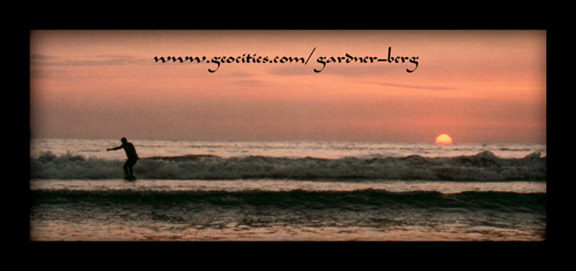
Surfing at Montanita, ECUADOR
| Translate: Espaņol - Franįais - Deutsch - Italiano - Portuguęs - Japanese - Korean - Chinese |

Surfing at Montanita, ECUADOR
| Translate: Espaņol - Franįais - Deutsch - Italiano - Portuguęs - Japanese - Korean - Chinese |

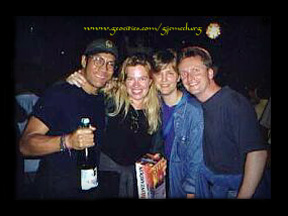 December 27 -- (0810) An early bus from Quito to Cuenca (3rd largest city in Ecuador and similar in altitude - 2530 m a.s.l.), where we stay a night. Then we head further south to Vilcabamba - the valley of longevity.
December 27 -- (0810) An early bus from Quito to Cuenca (3rd largest city in Ecuador and similar in altitude - 2530 m a.s.l.), where we stay a night. Then we head further south to Vilcabamba - the valley of longevity.
This small village town has a reputation where many of its inhabitants live to be over 100 years. No scientific basis has been found as yet. There are theories, however, put forward by scientists from Japan who recently visited Vilcabamba; e.g. cleaner air, slower and less stressful lifestyle, high elevation and more regular sleep patterns (at longer durations). Some autopsies have revealed the presence of more than usual blood vessels branching around the heart - which probably explains why heart attacks are few. And much to the shock of health authorities in the west - large bacterial colonies found in the normal flora.
December 31, 1999 -- Much to our dismay the day began with rain and our thoughts turned towards an indoor party. But it subsided in the evening and suddenly the town became alive. There was the traditional burning of the paper mache effigies on the streets to signify the destruction of the old to welcome the new and, of course, the consuming of alcoholic beverages - particularly the very potent aniseed liqueur that a few villagers shared with us.
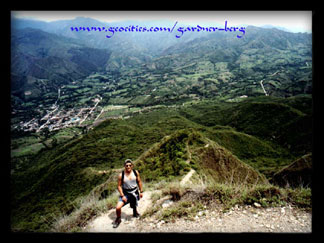
It was a great celebration.
January 2, 2000 -- We join 2 travellers from the USA on a hike on the Mandango trail for beautiful views of the town and its surroundings.
January 4, 2000 -- We say our goodbyes and head back to Cuenca where we stay a few days to change money and renew our visas. We also save a day to visit Ecuador's best preserved Precolumbian ruins - Ingapirca, 2 hours north by bus.
Built in the same way as those in Peru - i.e. masonry without the use of mortar - the fortess of Ingapirca, famous for its circular shape was built at the time of the conquest of the region of the Caņari.
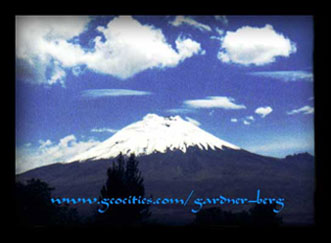
January 11, 2000 -- (0600) A 10 and a half hour bus ride back to Quito to meet with friends at our usual hotel in the Old Town.
January 14, 2000 -- (0800) All 4 of us head to 'Termas de Papallacta' - Papallacta Thermal Baths for an afternoon of relaxation.
January 17, 2000 -- Prices of goods and services begin to rise in Quito followed by increased public demonstrations. Over the next 5 days we decide to stock up on food and water (just in case). There is a lot of uncertainty on what will happen next.
The majority of the country wants to see its current president resign his position; a state of emergency has already been declared by the Government. So we shall see...
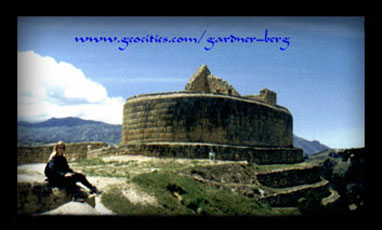 January 21, 2000 -- (0930) We're currently in the middle of civil unrest. The colonial section, where we are staying (Old Quito), is like a war zone. Walking to the New Town was with a lot of caution, but we got there OK.
January 21, 2000 -- (0930) We're currently in the middle of civil unrest. The colonial section, where we are staying (Old Quito), is like a war zone. Walking to the New Town was with a lot of caution, but we got there OK.
But as the day went by, the demonstrations became more and more intense. We could see on television at the Internet Cafe that it was nationwide. The whole country came to a standstill. It seems everyone has joined the Indigenous Group demonstrations in an attempt to depose the president - even a small section of the military had broken rank to side with the uprising.
At around 4 pm, we decide to walk back to our hotel. More difficulty. We zig-zagged around blocks, trying to avoid some of the hot-spots (looking for smoke on the street - e.g. teargas or burning tyres). But we got caught among a crowd of people running in the opposite direction, so we quickly cut into someone's courtyard, just before they shut their doors.
 When the street cleared, we stepped up the pace down the remaining 200 m to the relative safety of our hotel (as mentioned before, the hotel is situated 2 blocks SE from the Government Palace.)
When the street cleared, we stepped up the pace down the remaining 200 m to the relative safety of our hotel (as mentioned before, the hotel is situated 2 blocks SE from the Government Palace.)
It is now 8 pm and we see on television that about 8000 protesters have stormed the Palace - there was no resistance from the military at all. We could hear the crowd roaring outside our window - it was incredible.
Of course the President, himself, fled before all this took place to the safety of his military supporters.
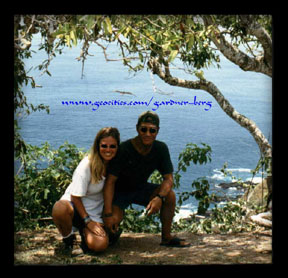 Around midnight, the Plaza de Independencia became a venue for celebration. Everyone there appeared in good spirits - even the military. It could well have been another Millenium Party!
Around midnight, the Plaza de Independencia became a venue for celebration. Everyone there appeared in good spirits - even the military. It could well have been another Millenium Party!
January 22, 2000 -- City returns back to normal. Clean up operations underway and the recommencement of transport services.
February 22, 2000 - After a month of rainy days, staying indoors socializing with other travellers we decide to head to the west coast for some sun, sand and, if we're lucky, a little surf.
A bus (0715) from Quito takes us on an 11 hour trip to Manta - a major port town and local holiday resort. We stay here for 3 nights before heading to Montaņita - 6 hours south from Manta.
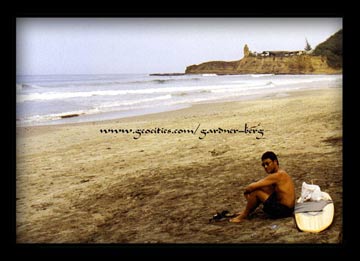 This small fishing/surfing village is certainly popular with foreign travellers and on weekends or holidays - locals from Guayaquil arrive by the hundreds.
This small fishing/surfing village is certainly popular with foreign travellers and on weekends or holidays - locals from Guayaquil arrive by the hundreds.
The seafood here is excellent, always fresh - mainly white sea bass, shrimp, and calamares. 6 days was spent entirely on longboarding, eating and drinking under the hot equatorial sun. We were lucky to arrive in Montaņita when we did. It was Carnival Week and from March 4 on, the village and the beach were just packed. All over Ecuador, particularly along the coastal region there is a tradition of throwing buckets of water at each other and no-one is spared. We couldn't walk anywhere without getting doused. It was a long week for us. March 9, 2000 -- A return to Quito to renew visas once again.
March 16, 2000 -- We head to the coast again. 11 hours to Manta for 2 days then onwards to Puerto Lopez - another fishing town and also an access point into the Machalilla National Park. This park extends also to Silver Island - La Isla de la Plata.
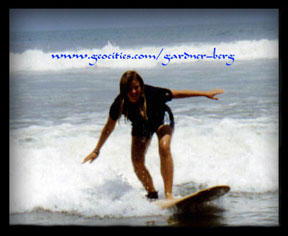 March 19, 2000 -- 42 km boat ride from Puerto Lopez to Isla de la Plata. This small island was once the site where Sir Francis
Drake had hidden treasure - hence its name. The island also serves as nesting grounds for various bird species and feeding grounds for many sea mammals and stingrays. Unlike the Galapagos Islands, Isla de la Plata was not formed by volcanic activity. It was once part of the mainland - that is until the Nazca plate activity ultimately caused its separation.
March 19, 2000 -- 42 km boat ride from Puerto Lopez to Isla de la Plata. This small island was once the site where Sir Francis
Drake had hidden treasure - hence its name. The island also serves as nesting grounds for various bird species and feeding grounds for many sea mammals and stingrays. Unlike the Galapagos Islands, Isla de la Plata was not formed by volcanic activity. It was once part of the mainland - that is until the Nazca plate activity ultimately caused its separation.
The nesting grounds we visited today were that of the Booby species (Blue-footed and Masked). We also viewed stingrays feeding in the surf of a protected beach.
After lunch, we head to a secluded area of the island to do some snorkelling. To be surrounded by colourful angelfish was, to us, the highlight of a great day.
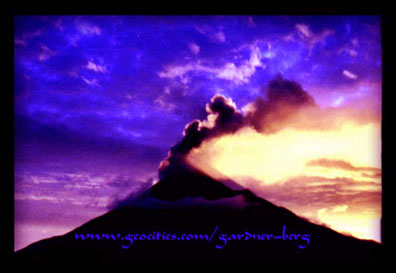 March 21, 2000 -- We leave Puerto Lopez and head to Montaņita once again for more longboarding. We stayed, this time, with the surfboard-shaper and his family (Moreno's Longboards Workshop) - we had a wonderful time with them for the entire 2 week visit including a couple of free rental days just for being good buddies.
March 21, 2000 -- We leave Puerto Lopez and head to Montaņita once again for more longboarding. We stayed, this time, with the surfboard-shaper and his family (Moreno's Longboards Workshop) - we had a wonderful time with them for the entire 2 week visit including a couple of free rental days just for being good buddies.
April 5, 2000 -- We say our goodbyes with the promise of returning in a couple of years and, hopefully arrive with an ability to form complete sentences in Spanish. We arrive in Quito the following day.
April 7, 2000 -- During our time on the coast, Quito and its surrounding area has suffered a constant onslaught of heavy rain, causing land slips and isolated flooding.
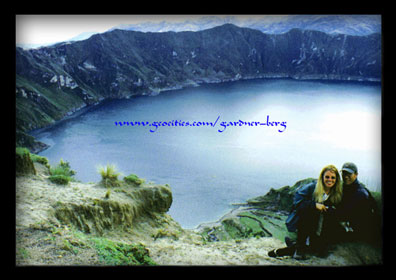 We are told at the hotel that Dolarisation is going to happen. Hundreds of large sacks of coins of various denominations in U.S. currency have arrived already. Free information about U.S. currency and what they look like are being handed out to everyone on the streets. Every store now has price tags in U.S. amounts. The dollar may be in full effect not long after Easter.
We are told at the hotel that Dolarisation is going to happen. Hundreds of large sacks of coins of various denominations in U.S. currency have arrived already. Free information about U.S. currency and what they look like are being handed out to everyone on the streets. Every store now has price tags in U.S. amounts. The dollar may be in full effect not long after Easter.
April 27 -- We leave Quito on a bus to Latacunga (2 hours south). Even
though the cities has much to offer as far as services go, small towns
like Latacunga are populated by very friendly and considerate people.
Quiet and tranquil during the week but, however, Fridays, Saturdays and
Sundays becomes crowded with life - particularly in the market area.
Meanwhile, far off in the distance, heavy clouds cross the skies and
congregate around the peak of Volcan Cotopaxi (29 km away to the north).

The following day begins early (5am), catching a bus to Zumbahua (2 hours away) - a small village set in a small pocket amidst beautiful and breathtaking surroundings completely covered in crops of various kinds eg. wheat barley, tubers, maize etc... resembling much like a giant patched quilt. Then another bus to Quilatoa village where there is a crater lake nearby. Great panoramic views from the crater rim of the lake's beautiful deep coloured waters.
With only a couple of weeks left on our 6-month stay in Ecuador, we begin making plans for our heading to Peru.
April 29 -- We bus back to Quito to pack, re-supply and say our goodbyes to our hosts and friends back at the hotel which we regarded as our home for nearly 6 months.
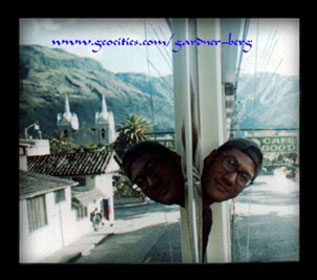 May 2 -- Our final exit from Quito on yet another bus to Banos - a small town
reknown for its thermal baths - very popular with foreign travellers. The
town itself is situated at the foot of a rather active volcano; Volcan
Tungurahua. Recently, Banos inhabitants evacuated the area with the threat of
explosions and debris falling dangerously close. Also the town itself is in
the direct path of lava flow should there be any full-scale eruption.
On our approach from the hills to the town below, we could see from the bus
the towering cone-shaped Tungurahua venting steam and ash into the clear sky.
A frightening but beautiful sight. Unlike the explosions from Guagua
Pichincha near Quito where they could not be heard, here in Banos we could
hear the booms even above the diesel engines of our bus.
May 2 -- Our final exit from Quito on yet another bus to Banos - a small town
reknown for its thermal baths - very popular with foreign travellers. The
town itself is situated at the foot of a rather active volcano; Volcan
Tungurahua. Recently, Banos inhabitants evacuated the area with the threat of
explosions and debris falling dangerously close. Also the town itself is in
the direct path of lava flow should there be any full-scale eruption.
On our approach from the hills to the town below, we could see from the bus
the towering cone-shaped Tungurahua venting steam and ash into the clear sky.
A frightening but beautiful sight. Unlike the explosions from Guagua
Pichincha near Quito where they could not be heard, here in Banos we could
hear the booms even above the diesel engines of our bus.
May 6 -- After a few days of short hikes and relaxing thermal baths, we head south again to Loja spending a couple of days there.
May 9 -- From Loja we catch a bus to the Ecuador/Peru border at Macara.
Photos and Text Copyright Š 1999-2001 Gardner-Berg. All rights reserved.
Sources of Further Reading-
Elliot, Elizabeth. "The Savage My Kinsman" 1996.
Howay, Frederick. "Atahualpa" 1978
MacDonald, Theodore. "Ethnicity and Culture Amidst New Neighbors: The Runa and Ecuador's Amazon Region".

